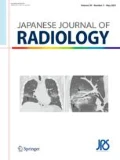Abstract
The "democratization of AI" is progressing, and it is becoming an era when anyone can utilize AI. What kind of radiologists are new generation radiologists suitable for the AI era? The first is maintaining a broad perspective regarding healthcare in its entirety. Next, it is necessary to study the basic knowledge and latest information concerning AI and possess the latest knowledge concerning modalities such as CT/MRI and imaging information systems. Finally, it is important for radiologists to not forget the viewpoint of patient-centered healthcare. It is an urgent task to nurture human resources by realizing such a healthcare AI education program to educate radiologists at an early stage. If we can evolve to become radiologists suitable for the AI era, AI will likely be our ally more than ever and healthcare will progress dramatically. As we approach the "democratization of AI," it is becoming an era in which all radiologists must learn AI as they learn statistics.



Similar content being viewed by others
References
Litjens G, Kooi T, Bejnordi BE, Setio AAA, Ciompi F, Ghafoorian M, et al. A survey on deep learning in medical image analysis. Med Image Anal. 2017;42:60–88.
Esteva A, Kuprel B, Novoa RA, Ko J, Swetter SM, Blau HM, et al. Dermatologist-level classification of skin cancer with deep neural networks. Nature 2017;542:115–118.
Haenssle HA, Fink C, Schneiderbauer R, Toberer F, Buhl T, Blum A, et al. Man against machine. diagnostic performance of a deep learning convolutional neural network for dermoscopic melanoma recognition in comparison to 58 dermatologists. Ann Oncol. 2018;29:1836–42.
Ehteshami Bejnordi B, Veta M, Johannes van Diest P, van Ginneken B, Karssemeijer N, Litjens G, et al. Diagnostic assessment of deep learning algorithms for detection of lymph node metastases in women with breast cancer. JAMA. 2017;318:2199–210.
Poplin R, Varadarajan AV, Blumer K, Liu Y, McConnell MV, Corrado SG, et al. Prediction of cardiovascular risk factors from retinal fundus photographs via deep learning. Nature Biomedical Engineering. 2018;2:158–64.
https://www.fda.gov/newsevents/newsroom/pressannouncements/ucm604357.htm
Lakhani P, Sundaram B. Deep Learning at Chest Radiography: Automated Classification of Pulmonary Tuberculosis by Using Convolutional Neural Networks. Radiology. 2017;284:574–82.
Rajpurkar P, Irvin J, Zhu K, Yang B, Mehta H, Duan T, et al. CheXNet: radiologist-level pneumonia detection on chest X-rays with deep learning. 2017.arXiv:1711.05225.
Prevedello LM, Erdal BS, Ryu JL, Little KJ, Demirer M, Qian S, et al. Automated critical test findings identification and online notification system using artificial intelligence in imaging. Radiology. 2017;285:923–31.
Titano JJ, Badgeley M, Schefflein J, Pain M, Su A, Cai M, et al. Automated deep-neural-network surveillance of cranial images for acute neurologic events. Nat Med. 2018;24:1337–41.
Nakao T, Hanaoka S, Nomura Y, Sato I, Nemoto M, Miki S, et al. Deep neural network-based computer-assisted detection of cerebral aneurysms in MR angiography. J Magn Reson Imaging. 2018;47:948–53.
Larson DB, Chen MC, Lungren MP, Halabi SS, Stence NV, Langlotz CP. Performance of a deep-learning neural network model in assessing skeletal maturity on pediatric hand radiographs. Radiology. 2018;287:313–22.
Kunimatsu A, Kunimatsu N, Yasaka K, Akai H, Kamiya K, Watadani T, et al. Machine learning-based texture analysis of contrast-enhanced MR Imaging to differentiate between glioblastoma and primary central nervous system lymphoma. Magn Reson Med Sci. 2018. https://doi.org/10.2463/mrms.mp.2017-0178.
Yasaka K, Akai H, Abe O, Kiryu S. Deep learning with convolutional neural network for differentiation of liver masses at dynamic contrast-enhanced CT: a preliminary study. Radiology. 2018;286:887–96.
Trivedi H, Mesterhazy J, Laguna B, Vu T, Sohn JH. Automatic determination of the need for intravenous contrast in musculoskeletal MRI examinations using IBM Watson's natural language processing algorithm. J Digit Imaging. 2018;31:245–51.
Yasaka K, Akai H, Kunimatsu A, Abe O, Kiryu S. Deep learning for staging liver fibrosis on CT: a pilot study. Eur Radiol. 2018. https://doi.org/10.1007/s00330-018-5499-7.
Zhu B, Liu JZ, Cauley SF, Rosen BR, Rosen MS. Image reconstruction by domain-transform manifold learning. Nature. 555(7697):487-492. https://doi.org/10.1038/nature25988
Noguchi T, Higa D, Asada T, Kawata Y, Machitori A, Shida Y, et al. Artificial intelligence using neural network architecture for radiology (AINNAR): classification of MR imaging sequences. Jpn J Radiol. 2018. https://doi.org/10.1007/s11604-018-0779-3.
Han X. MR-based synthetic CT generation using a deep convolutional neural network method. Med Phys. 2017;44:1408–19.
Yasaka K, Akai H, Kunimatsu A, Kiryu S, Abe O. Deep learning with convolutional neural network in radiology. Jpn J Radiol. 2018;36:257–72.
García-Figueiras R, Baleato-González S, Padhani AR, Luna-Alcalá A, Marhuenda A, Vilanova JC, et al. Advanced imaging techniques in evaluation of colorectal cancer. Radiographics. 2018;38:740–65.
https://business.nikkeibp.co.jp/atcl/opinion/15/221102/051100577
Nakajima Y, Yamada K, Imamura K, Kobayashi K. Radiologist supply and workload: international comparison. Working Group of Japanese College of Radiology. Radiat Med. 2008;26:455–65.
Obermeyer Z, Emanuel EJ. Predicting the future - big data, machine learning, and clinical medicine. N Engl J Med. 2016;375:1216–9.
Author information
Authors and Affiliations
Corresponding author
Ethics declarations
Conflict of interest
YK has received a research grant from Canon Medical Systems. MI and HK has no conflict of interest.
About this article
Cite this article
Kobayashi, Y., Ishibashi, M. & Kobayashi, H. How will “democratization of artificial intelligence” change the future of radiologists?. Jpn J Radiol 37, 9–14 (2019). https://doi.org/10.1007/s11604-018-0793-5
Received:
Accepted:
Published:
Issue Date:
DOI: https://doi.org/10.1007/s11604-018-0793-5



